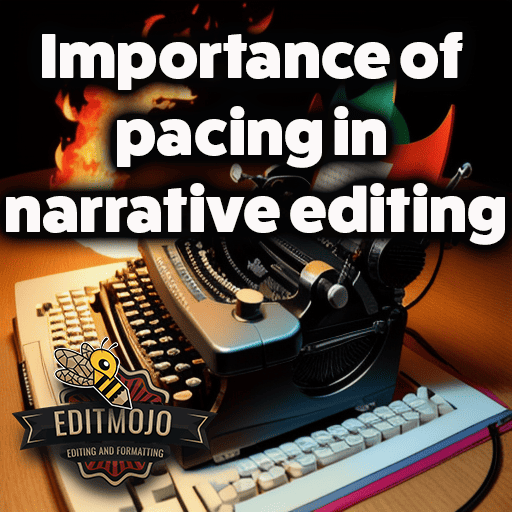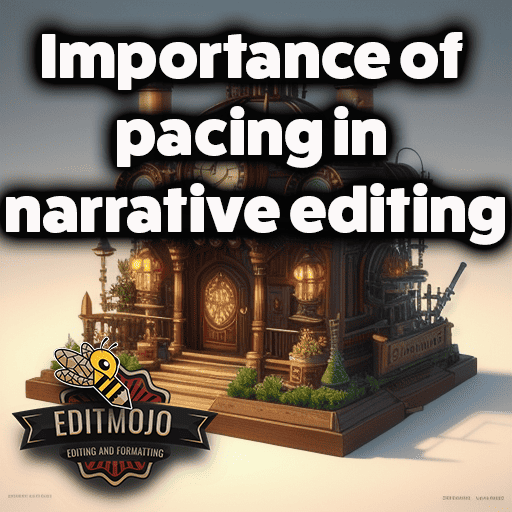Importance of pacing in narrative editing
Importance of pacing in narrative editing. Narrative pacing, like the rhythm in a melody, sets the tone, mood, and overall reading experience of a story. It is the tempo at which your narrative progresses; it’s about timing and the rhythm that glues your readers to the book. As Edgar Allan Poe once said, “A short story must have a single mood and every sentence must build towards it.”
In this post, we delve into the nuanced world of narrative pacing, its importance, and the art of balancing it effectively to keep your readers enthralled.
II. Understanding the Concept of Pacing in Storytelling
Narrative pacing has existed since humans began telling stories, painting pictures on cave walls, or composing epic poems. However, with the evolution of storytelling mediums, understanding pacing and its role has become more crucial than ever.
At its core, pacing in a narrative is about timing—when to reveal key plot points, when to build suspense, or when to give your readers a breather. Why is it necessary? The pace of a narrative dictates the reader’s emotional journey, holding the power to make them eagerly turn pages or lose interest entirely.

III. Exploring Different Types of Pacing
Like the varied notes in a symphony, pacing can be slow, fast, or medium, each carrying its unique impact on narratives.
Slow pacing allows for in-depth character development and world-building. It gives readers time to soak in the atmosphere and connect deeply with the characters. However, it risks losing reader interest if not handled carefully.
Fast pacing keeps readers on their toes, perfect for thriller and action narratives. Yet, if too much happens too quickly, readers may feel overwhelmed or disconnected from the characters.
Medium pacing strikes a balance between action and depth, creating a rhythmic flow. Though, finding this sweet spot can be challenging.
IV. Case Studies: Success of Pacing in Notable Narratives
Let’s turn to a few examples where pacing has played a pivotal role.
- “War and Peace” by Leo Tolstoy: Renowned for its slow pacing, this novel lets readers dwell in its grandeur and intricacies, turning a historical tale into a timeless masterpiece.
- “The Da Vinci Code” by Dan Brown: Brown’s fast-paced narrative maintains a nail-biting tension throughout, making it a page-turner.
- “To Kill a Mockingbird” by Harper Lee: This classic combines slow-paced scenes with bursts of faster pacing, offering readers a well-rounded narrative experience.

V. Common Myths and Misconceptions about Pacing
Contrary to common misconceptions, fast pacing isn’t always better. Both slow and medium pacing can be equally engaging if executed well. Another myth is that pacing equals plot. While they’re interconnected, pacing involves timing and rhythm, whereas plot revolves around events and their sequence in the story.
VI. Common Mistakes in Pacing and How to Avoid Them
Inconsistent pacing and neglecting pacing altogether are two common mistakes editors and authors make.
Here’s a step-by-step guide to avoid these pitfalls:
- Outline your story: Highlight key events and decide where to slow down or speed up.
- Read aloud: This helps to identify awkward transitions or jarring pace changes.
- Get feedback: Other readers or editors can spot pacing issues you might have missed.
VII. The Secrets of Effective Pacing
In the words of acclaimed editor Sol Stein
, “A novel is like a car—it won’t go anywhere until you step on the accelerator.” Timing, suspense, cliffhangers, sentence structure, and chapter length are all tools for controlling your narrative’s speed.
Interviews with experts, like Stephen King, reveal that conscious pacing makes the difference between amateur and professional writing.
VIII. The Impact of Pacing on Readers’ Engagement
Pacing keeps readers engrossed by managing their emotional journey. A well-paced narrative strikes a balance between action, dialogue, description, and introspection. Without effective pacing, a narrative can become dull or chaotic, discouraging readers from continuing.

IX. Personal Anecdotes on Pacing
Famed author J.K. Rowling admitted struggling with pacing in “Harry Potter and the Order of the Phoenix”, leading to an unusually long book. This example emphasizes that pacing is an ongoing learning process, even for successful authors.
X. Implementing Pacing in Your Editing – A Step-by-step Guide
- Identify the pace of your story: Determine if it should be fast, medium, or slow based on the genre, plot, and characters.
- Use pacing tools: Mix short and long sentences, control the flow of information, use cliffhangers and suspense to manipulate pace.
- Edit with pacing in mind: Look for sections where the pace may be dragging or rushing.
XI. Inspiration for Pacing: Quotes and Messages
Remember the words of Ray Bradbury: “Plot is no more than footprints left in the snow after your characters have run by on their way to incredible destinations.”
XII. Ways to Improve Your Understanding and Utilization of Pacing
- Read widely and analyze the pacing in different narratives.
- Write consistently and experiment with pacing.
- Seek feedback from readers and fellow writers.
XIII. Conclusion: Summarizing the Importance of Pacing in Narrative Editing
Why you need to master pacing? It’s simple: to make your story engaging and emotionally satisfying. What to expect? As you practice pacing, you’ll notice your narratives becoming more dynamic and captivating. As American novelist James Salter once said, “Life is weather. Life is meals. Lunches on a blue checked cloth on which salt has spilled. The smell of tobacco. Brie, yellow apples, wood-handled knives.”
We urge you to pay attention to pacing in your next writing or editing process.
Key Takeaways
| Key Points | Takeaway |
|---|---|
| Understanding Pacing | Pacing is the tempo at which your narrative unfolds. It’s crucial for maintaining reader interest and guiding their emotional journey. |
| Types of Pacing | Slow, fast, and medium pacing have different impacts on narratives and must be chosen wisely. |
| Myths and Misconceptions | Fast pacing isn’t always better, and pacing doesn’t equal plot. |
| Common Mistakes | Common pacing mistakes include inconsistency and ignoring pacing. These can be avoided with careful outlining, reading aloud, and getting feedback. |
| Secrets of Effective Pacing | Tools like timing, suspense, cliffhangers, and sentence structure can help control pacing effectively. |
| Importance of Pacing | Pacing is vital to keep readers engaged and create an emotionally satisfying narrative. |
Top Five Questions about Pacing in Narrative Editing
Q1: What is pacing in narrative editing?
A: Pacing is the speed and rhythm at which a story progresses, influencing the reader’s engagement and emotional journey.
**Q2: Why is pacing important in a narrative?
**
A: Pacing is vital because it dictates the reader’s emotional journey and can make them eagerly turn pages or lose interest.
Q3: What are common mistakes in pacing?
A: Common mistakes include inconsistent pacing, ignoring pacing, and equating pacing with the plot.
Q4: How can one improve their understanding and utilization of pacing?
A: By reading widely, analyzing pacing in different narratives, writing consistently, experimenting with pacing, and seeking feedback.
Q5: What’s the relationship between pacing and plot?
A: While interconnected, they are different. Pacing involves timing and rhythm, whereas plot revolves around events and their sequence in the story.
XIV. References
To understand pacing better, it’s important to dive deeper into the wealth of knowledge shared by experts in the field. Here are a few sources that helped shape this article:
- “Stein On Writing” by Sol Stein
- “On Writing: A Memoir of the Craft” by Stephen King
- Ray Bradbury’s advice on Writing
- James Salter on the Art of Fiction
XV. Further Reading
The journey of mastering pacing does not end here. We recommend the following resources for those keen on enhancing their skills further:
- “The Artful Edit: On the Practice of Editing Yourself” by Susan Bell
- “Revision and Self-Editing for Publication” by James Scott Bell
- Reedsy’s guide on Narrative Pacing
Remember, pacing in narrative editing is as essential as rhythm in music. It sets the tone, mood, and emotion of your story. Mastering it can turn an average narrative into a captivating tale that readers cannot put down. Your narrative is a symphony, and pacing is your conductor’s baton—wield it with precision to create a piece that resonates with readers long after they’ve finished reading.
